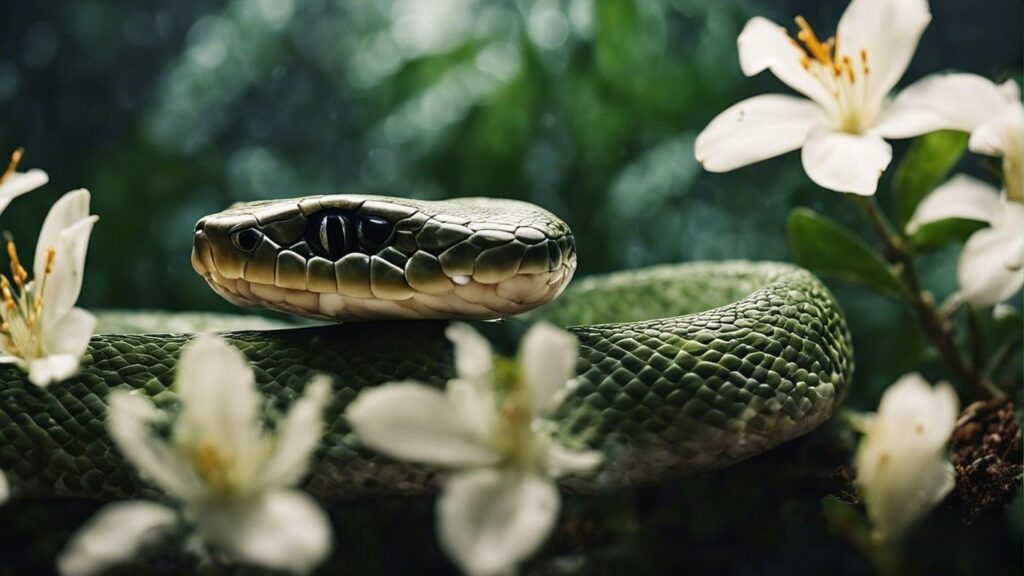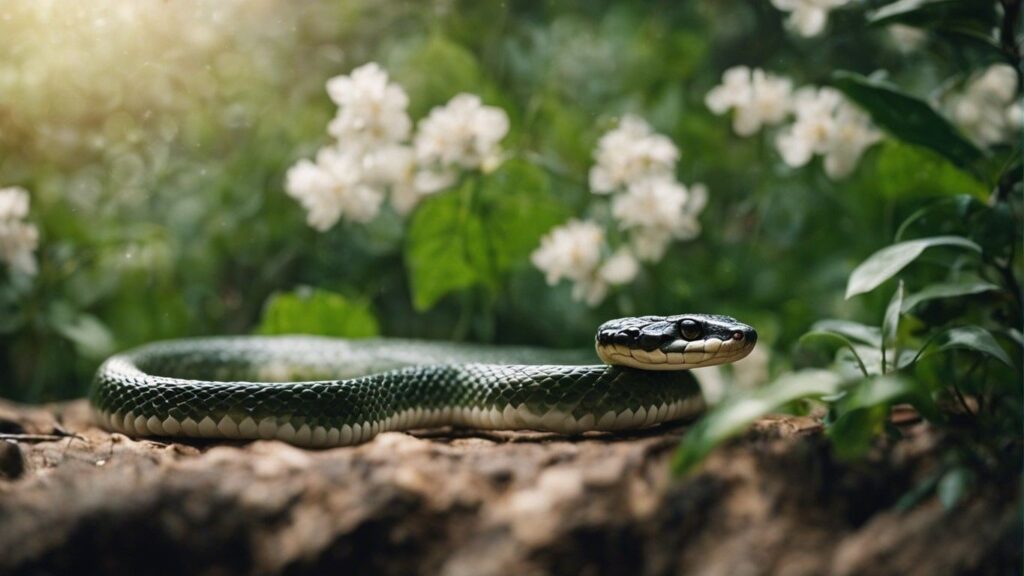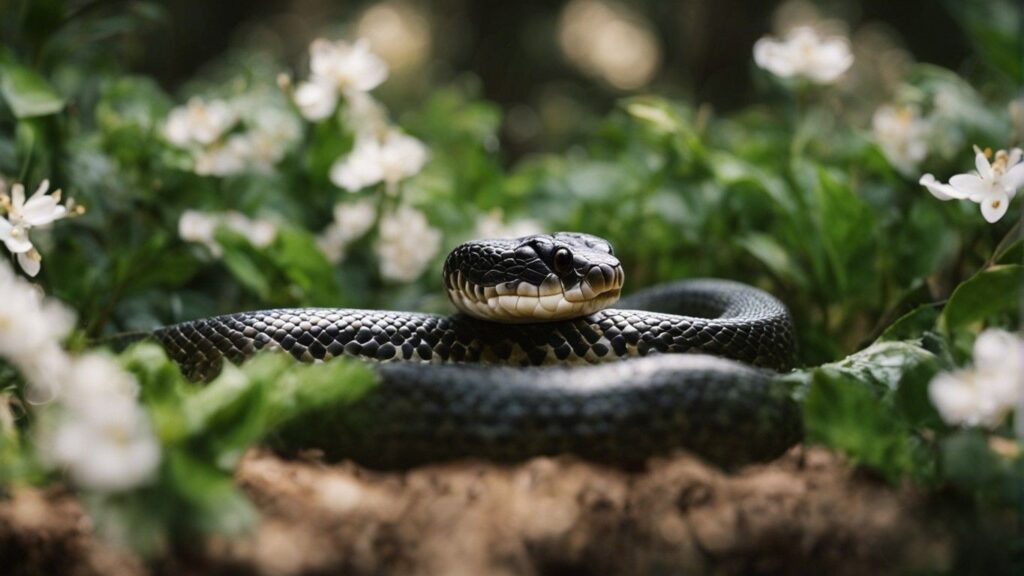You’ve probably heard that certain plants attract certain animals, like bees to flowers or butterflies to milkweed.
But what about snakes and jasmine? Are these slithering creatures drawn to the enchanting scent of jasmine?
In this article, we’ll uncover the truth behind this popular belief and explore whether jasmine has any snake-charming powers.
So, sit back and prepare to uncover the fascinating relationship between these two natural wonders.

Overview
Understanding the relationship between jasmine and snakes
Have you ever wondered if planting jasmine in your garden could attract snakes? Well, you’re not alone.
There seems to be a common belief that snakes are attracted to jasmine plants, but is there any truth to this claim?
In this article, we will delve into the topic and explore the factors that attract snakes, examine the characteristics of jasmine, and address the myth regarding jasmine and snake attraction.
Snake Habitat Preferences
Identifying snake habitats
Snakes are found in a variety of habitats around the world. From forests to deserts, they have adapted to survive in different environments.
Understanding the preferred habitats of snakes can provide insights into their presence near jasmine plants.
Common snake habitats include grasslands, wetlands, forests, and even urban areas.
Analyzing snake behavior and preferences
Snakes, being cold-blooded creatures, rely heavily on their environment to regulate their body temperature.
Therefore, they seek out areas that provide them with warmth, shelter, food, and water. Snakes are known to prefer areas with ample vegetation cover, such as tall grass, shrubs, and rocks, which provide hiding places and protection from predators.
These preferences can influence their presence in and around jasmine plants.
Exploring factors that influence snake presence
Apart from habitat preferences, other factors also play a role in attracting snakes. Food availability is one such factor.
Snakes are attracted to areas where there is a sufficient supply of their preferred prey, such as rodents, birds, or amphibians.
Additionally, the presence of water sources like ponds or streams can further attract snakes to a particular location.
Characteristics of Jasmine
Introducing jasmine plant and its attributes
Jasmine, a flowering plant belonging to the Oleaceae family, is known for its fragrant flowers and glossy green leaves.
There are various species of jasmine, with the Arabian jasmine (Jasminum sambac) being the most commonly recognized.
This versatile plant can be found in gardens, bouquets, and even used in perfumes due to its alluring fragrance.
Highlighting the fragrance and appearance of jasmine
One of the distinguishing features of jasmine is its fragrance, which is widely appreciated for its sweet and heavenly scent. The scent of jasmine flowers can vary slightly between species, with some emitting a stronger fragrance than others. In addition to their fragrance, jasmine flowers also boast an elegant appearance, typically consisting of five or six petals that can be white, yellow, or even pink.
Exploring the scientific aspects of jasmine
From a scientific perspective, the aromatic compounds responsible for the fragrance of jasmine are called volatile organic compounds (VOCs).
These VOCs are released by the flowers and are believed to attract insects for pollination. However, it is important to note that the fragrance of jasmine is intended to attract insects, not snakes.
Snake Attraction Factors
Examining factors that attract snakes
While jasmine may be a captivating plant for humans, it is crucial to understand that the factors that attract snakes primarily revolve around their survival needs.
Snakes are attracted to areas where they can find suitable shelter, abundant food sources, and access to water.
The belief that snakes are specifically drawn to jasmine plants is not backed by scientific evidence.
Understanding snake olfactory senses
Snakes possess highly developed olfactory senses, meaning they have a keen sense of smell.
They use this sense to locate prey, navigate their environment, and communicate with other snakes.
However, the alluring scent of jasmine is not known to be particularly attractive or relevant to snakes.
Exploring relevant research and studies
Scientific research on the topic of jasmine attracting snakes is limited. Studies conducted on snake behavior and habitat preferences have not identified jasmine as a significant factor in attracting snakes.
Instead, these studies focus more on snake preferences for specific habitats, temperature conditions, and availability of prey.
Common Snake Repellents
Discussing commonly used snake repellents
Concerns about snake encounters often lead to exploring methods to deter snakes from specific areas.
Many individuals resort to using snake repellents as a preventative measure. These repellents can be broadly categorized into natural and chemical options.
Exploring natural and chemical repellents
Natural snake repellents typically contain essential oils derived from plants such as cinnamon, cloves, or cedarwood.
These oils are believed to produce scents that snakes find unpleasant, potentially deterring them from entering certain areas.
On the other hand, chemical repellents often contain synthetic ingredients or compounds that emit strong odors, aiming to drive snakes away.
Addressing the effectiveness of these repellents
The effectiveness of snake repellents can vary, and it is essential to approach their usage with caution.
While certain natural or chemical repellents may have some deterrent effect, they are not foolproof solutions.
Factors such as the species of snake, environmental conditions, and individual behavior can influence the effectiveness of repellents.
It is wise to consider multiple deterrence techniques in conjunction with repellents for optimal results.

Snakes and Their Senses
Understanding snakes’ sensory abilities
To comprehend the relationship between snakes and the environment, it is crucial to understand their sensory abilities.
Snakes have several unique sensory adaptations, including specialized receptors for detecting heat, light, vibration, and scent.
These sensory capabilities enable them to locate prey, avoid predators, and navigate their surroundings.
Exploring how snakes locate prey
Snakes primarily rely on their heat-sensing abilities to detect prey. This is achieved through specialized pit organs located on their head or body.
These pits allow snakes to detect the infrared radiation emitted by warm-blooded animals. Snakes also possess a keen sense of smell, which helps them track down potential meals.
Analyzing snakes’ response to different scents
While snakes have a sense of smell, their response to specific scents is generally geared towards their hunting instincts rather than being attracted to certain smells.
Snakes are more likely to be attracted to the presence of prey, predators, or potential mates based on scent cues, rather than being drawn in by the fragrance of jasmine or other aromatic plants.
Misconceptions about Jasmine
Addressing the myth that jasmine attracts snakes
The belief that jasmine attracts snakes is a common misconception. There is no scientific evidence to support this claim.
While snakes may occasionally be found in areas with jasmine plants, their presence is likely due to other factors such as habitat suitability or natural snake behavior.
However, it is important to exercise caution and be aware of your surroundings when encountering snakes, regardless of the presence of jasmine.
Examining the origin of this misconception
The origin of the belief that jasmine attracts snakes is unclear. It could be a result of cultural folklore, personal anecdotes, or the association of snakes with hidden or overgrown areas where jasmine plants might thrive.
Regardless of its origin, it is crucial to rely on scientific evidence and research to separate fact from fiction.
Presenting evidence against the snake attraction claim
Scientific studies and research have consistently failed to establish a direct correlation between jasmine plants and snake attraction.
Snakes are primarily attracted to habitats that provide them with food, shelter, and water sources – factors that are unlikely to be influenced significantly by the presence of jasmine.
It is essential to dispel these myths and base our understanding on evidence-based information.

Jasmine Benefits and Uses
Highlighting the positive aspects of jasmine
While jasmine may not attract snakes, it does offer numerous benefits and uses. The pleasant fragrance of jasmine flowers can provide aromatherapy benefits, promoting relaxation and stress relief.
Additionally, jasmine has been used in traditional medicine for its potential anti-inflammatory, antioxidant, and antimicrobial properties.
Exploring jasmine’s various applications
Jasmine finds a wide range of applications beyond its use in gardens and landscaping. The delicate flowers often find their way into perfumes, cosmetics, and scented candles due to their enchanting fragrance.
Jasmine tea, made from dried jasmine flowers, is sought after for its soothing aroma and potentially calming effects.
Examining the cultural significance of jasmine
Jasmine holds cultural significance in many regions around the world. In several Asian countries, it is revered as a symbol of purity, humility, and love.
Jasmine garlands are used in religious ceremonies, weddings, and other auspicious occasions.
The cultural and symbolic importance of jasmine highlights its deep-rooted connection with human history and traditions.
Snake Deterrence Techniques
Providing methods to deter snakes
To prevent snake encounters around your property, it is vital to employ snake deterrence techniques.
Some effective methods include keeping your yard clean and uncluttered, sealing off potential entry points, removing excess vegetation or debris, and installing snake-proof fencing.
By creating an environment that is less attractive to snakes, you can significantly reduce the chances of encountering them.
Exploring humane snake control strategies
In situations where snakes pose a direct threat to human safety, it may be necessary to seek professional assistance from wildlife control experts.
These professionals are trained in humane snake removal techniques and can relocate snakes away from human-populated areas.
It is important to prioritize both the safety of humans and the well-being of snakes during such encounters.
Highlighting prevention measures for snake encounters
Prevention is key when it comes to snake encounters. By implementing measures such as regular property maintenance, clearing out potential hiding spots, and educating yourself and your family about snake safety, you can significantly minimize the likelihood of unwanted snake encounters.
Being aware of the potential risks and taking appropriate precautions can go a long way in creating a safer environment.
Conclusion
Summarizing the evidence and findings
After a comprehensive exploration of the relationship between snakes and jasmine, it is clear that the belief that jasmine attracts snakes is unfounded.
Scientific research and studies have consistently failed to establish a direct link between jasmine plants and snake attraction.
Snakes are primarily attracted to suitable habitats, food sources, and water availability, factors that are not significantly influenced by the presence of jasmine.
Reiterating the lack of correlation between jasmine and snake attraction
While jasmine may be attractive to us for its fragrance and aesthetic appeal, it does not pose a significant attraction to snakes.
Snake presence near jasmine plants is more likely to be coincidental rather than directly influenced by the plant itself.
Understanding the factors that truly attract snakes can help dispel myths and promote a more accurate understanding of their behavior.
Encouraging a balanced perspective and understanding
When it comes to snakes and jasmine, it is important to approach the topic with a balanced perspective and understanding.
While snakes may occasionally be found near jasmine plants, it is essential to prioritize scientific evidence and research over unfounded beliefs.
By focusing on creating suitable habitats for snakes and implementing preventive measures, we can coexist with these creatures and appreciate the beauty of plants like jasmine without unnecessary fear or concern.



